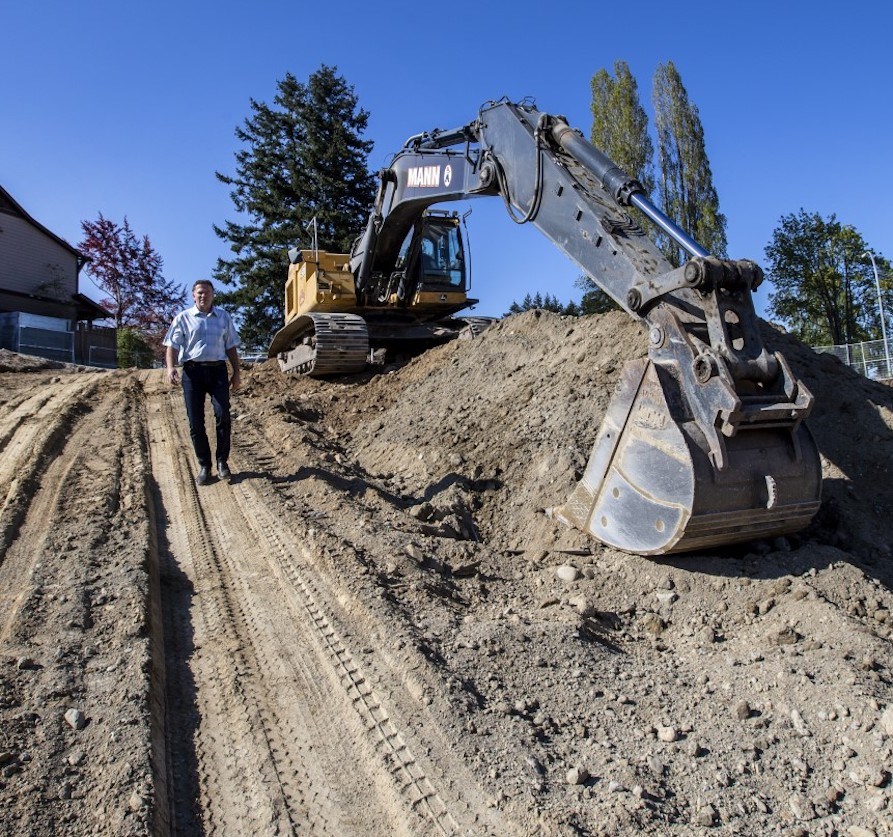Greater Victoria’s ongoing building boom is piling up a new challenge: where to put the tons of dirt being excavated for new commercial buildings, residential projects and underground parking garages?
It’s a question that’s of increasing concern to both the construction industry and residents of the rural areas on Vancouver Island where much of the uncontaminated soil or “clean fill” gets dumped on private properties — sometimes in such massive amounts that it alters the landscape.
People who moved to Metchosin, Shawnigan Lake or the Juan de Fuca Electoral Area for a more bucolic existence now find themselves dealing with big-city problems like dust, traffic noise and window-rattling vibrations as hundreds of trucks rumble past, loaded with dirt from construction sites in Victoria, Colwood or Langford.
In some cases, residents are pressing councils to adopt tougher soil-dumping bylaws and crack down on property owners who skirt the rules by taking dirt without a permit.
In the Juan de Fuca Electoral Area, director Mike Hicks said managing soil dumping has become an “administrative nightmare” that consumes a lot of staff time. As a result, the area is in the process of updating its soil deposit bylaw to better manage the issue, recoup costs and minimize the impact on residents, he said.
“A lot of the fill is coming from Langford and Colwood, and I’m talking thousands of trucks; I’m not talking a couple of trucks,” Hicks said.
“It’s the downside to the building booms that we’re seeing,” said B.C. Green Party Leader Sonia Furstenau, who represents the Cowichan Valley and Shawnigan Lake, where much of the fill gets deposited.
The construction industry, meanwhile, says the soil has to go somewhere, that many land owners require clean fill to level their properties or prepare sites for development, and that strict rules are in place to protect the environment.
Industry officials warn that if councils keep passing tougher bylaws and closing dump sites, companies will have to haul more clean soil out to sea or farther up the Island, which will burn fossil fuels, raise housing prices and slow development.
“The construction industry is very responsible,” said Monty Fitz, general manager of Don Mann Excavating Ltd. “We want to abide by all the regulations. We just feel that nobody really wants to help us solve this. They just want to push it to another community.
“So the Greater Victoria area pushed it to the [Cowichan Valley Regional District]. Well, the CVRD now comes along and says: ‘Well, you know what? We don’t want it either, let’s push it to the next district.’ And that is the reality of fill.”
Construction officials say the situation is fast reaching a crisis point as costs skyrocket and threaten to undermine efforts to build more affordable housing. The situation has been exacerbated, they say, by the closure of several large dump sites in the CVRD that reached the limit of fill they were allowed to receive under permit.
“We’re driving development on one hand and on the other hand we’re constrained by where do we put excavated material?” said Rory Kulmala, chief executive officer of the Vancouver Island Construction Association. “There’s not a lot of places anymore. We have a high demand, yet no place for it.”
That’s why some industry insiders, rural residents and politicians want the provincial government to get more involved and help resolve the impasse.
B.C.’s Environment Ministry said it’s working on changes that will streamline the process.
At present, the province regulates the movement of contaminated soil under the Environment Management Act and the Contaminated Sites Regulation But there is no notification requirements for the relocation of uncontaminated soil.
The new rules will require those moving uncontaminated soils to first notify the ministry, municipality, or Indigenous Nation through an online platform, the ministry said in a statement.
Meanwhile, municipalities are scrambling to stay on top of the issue.
In the Cowichan Valley, the regional district adopted a soil deposit bylaw in 2019 to better regulate dumping, but the issue remains a sore point for many residents, officials say.
“I think what the public believed was once we had the soil bylaw, the trucks would stop rolling,” said Sierra Acton, who represents Shawnigan Lake on the CVRD board. “And they haven’t. They’ve probably come more furiously now because Victoria has less space to take it — or none. And they are just sending it up here.”
In the Juan de Fuca are, Hicks is seeking compromise.
“We don’t want to be saying to our good neighbours: ‘You can’t bring your soil here,’ because they have to take it somewhere. But we’ve got to find a balance that it doesn’t cost the taxpayers out here any money or inconvenience to have it come.
“And that’s what we’re trying to figure out right now.”



